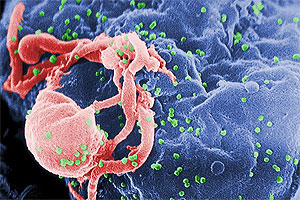 People with the delta 32 version of the CCR5 gene are more
People with the delta 32 version of the CCR5 gene are more
resistant to HIV infection.
Doctors announced in Berlin that a man who received a bone marrow transplant for leukemia was now also free of his HIV infection. Looks like this patient's luck is finally turning around!
Both leukemia and AIDS are diseases of the blood. Bone marrow transplants cure leukemia by permanently replacing the patient's blood with the donor's. This eliminates the cancerous blood cells and so cures the cancer.
One "side effect" of a bone marrow transplant is that the patient's blood cells now have donor's DNA. This sometimes makes for problems at crime scenes (and interesting CSI episodes). But here the doctor used it to the patient's advantage.
Scientists have known for a long time that people with two copies of a certain version of the CCR5 gene, the delta 32 version, are much more resistant to HIV. Their AIDS symptoms also tend to progress much more slowly.
So the doctors reasoned that if the patient were going to receive a bone marrow transplant anyway, why not give him one from a donor with two copies of delta 32? And that’s just what the doctors did.
